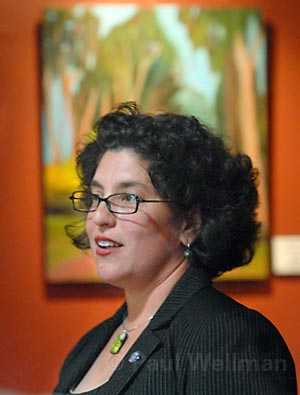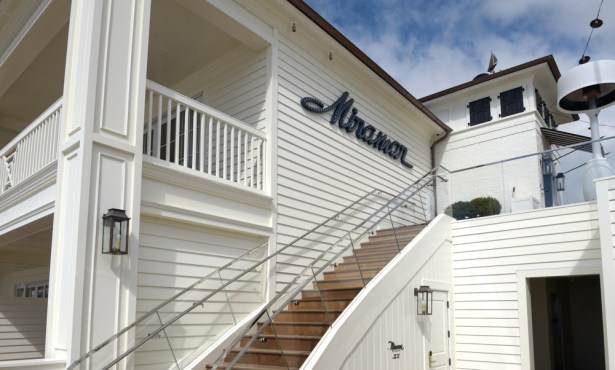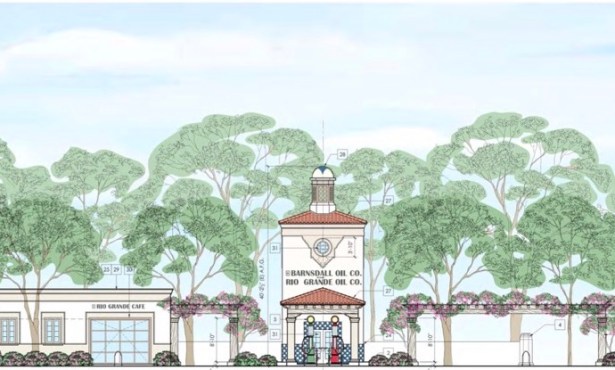White Flag on Blue Line
Proponent Withdraw Controversial Global Warming Project
Bruce Caron – a proponent for the Light Blue Line, the controversial 1,000-foot strip of blue paint slated for the streets of Santa Barbara to highlight the threat of global warming – has decided to withdraw his application from City Hall. Caron’s decision came just two days after developer and real estate baron Jerry Beaver announced the formation of a committee dedicating to keeping the Light Blue Line off the city’s streets. The proposed project has been the subject of intense criticism in the pages of the Santa Barbara News-Press almost since the day the City Council approved it two months ago.
Additionally, real estate interests have jumped into the fray, arguing that properties on the wrong side of the blue line could suffer diminution of property values. The line was designed to illustrate where Santa Barbara’s new sea shore would be if and when Greenland’s ice sheets were to melt as a result of global warming and, consequently, the sea level were to rise 21 feet. Some real estate operators worried that owners of properties lying between the ocean and the line might be required to disclose this fact to prospective buyers. With a city council election just around the corner, the issue of global warming – or at least the public art designed to address it – had grown too hot.

Caron and councilmember Helene Schneider – who spearheaded council efforts on behalf of the Light Blue Line – argued that the controversy surrounding the project helped focus public attention on the issue of global warming. The first objection leveled against the proposal was cost; City Hall had earmarked up to $12,000 for city staff to help Caron and his team of volunteers apply the paint to downtown city streets. Schneider sought to mollify the fiscal critics of the project by securing the funds from a private donor, but then the objections shifted. The real estate lobby got on board, complaining about prospective loss of property value. Fanning the fames of this dispute was the News-Press and its editorial page editor, Travis Armstrong.
A polarizing figure in Santa Barbara politics, Armstrong has crossed swords with many members of the City Council. In part because of this, some council members were extremely reluctant to abandon the project. “I hate to say it, but Travis won. You saw how the Orioles lost by 30-to-3. We’ll, we lost just 100-to-nothing,” said City Councilmember Brian Barnwell. “I was really looking forward to making our case. We never even got an at bat. We only played half an inning. The public never really got to hear our side of the story.”

That story, according to Barnwell, is that the idea was kicked around in various city review commissions for over an a year before the council approved it; that even the Historic Landmarks Commission, which Barnwell termed “arguably the most persnickety commission we have,” approved it with minor modification two weeks ago. “I got a call from [developer] Jeff Bermant saying how the project made him nervous,” Barnwell recalled. “What I should have told him is, ‘That’s what it’s supposed to do. You should feel nervous. You should feel nervous because global warming is a really scary issue.’ I think the project would have helped make that point.” A real estate appraiser by training, Barnwell said he would have loved to challenge anyone arguing their real estate values would have been hurt by the temporary line. Like Schneider and other blue line advocates, Barnwell said the city’s real estate maps are already inscribed with far more ominous squiggles – those showing the locations of earthquake fault lines, flood maps, fire zones, and tsunami threats.
Critics of the Light Blue Line have countered the proposed sea rise lines the basis of considerable scientific scrutiny and public debate. Not all scientists believe, they pointed out, that Greenland will in fact melt. Supporters of the line, like Caron, insist the line was designed as a precautionary statement, designed to illustrate the worst case scenario if humans did not change behavior contributing to global warming.
Councilmember Schneider said she was sad that Caron opted to the pull the project, but said she supported his decision. “I think it was the right thing to do,” she said. “The whole thing had gotten so divisive that the real point of the project got lost and overshadowed. It was just getting out of hand.” Schneider said she was surprised by the degree of vehemence and irritation about the project, especially from people she encountered outside the usual activist circles. “You’d hear people go, ‘Oh my God I’m going to lose my mortgage.’ But they weren’t freaking out about the real threat but about a little paint on the street. The whole thing is sad.”



